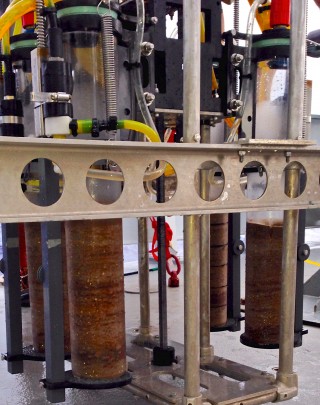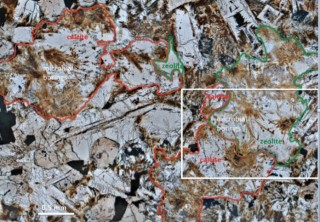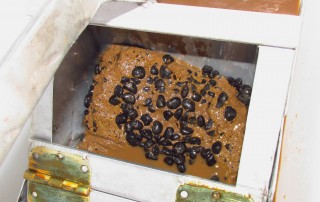We will all be heading home in a day or two.

Often the person that I sit beside on a plane will ask companionably where I’m headed or what I have been doing in the place I’m leaving. Mostly my travels are related to work, so the next question is, “What kind of science do you do?” I say I’m a marine geologist and the frequent response is, “Oh, so you study whales and dolphins?” I’d smile and say, “No, that’s biology, actually I study volcanoes and structures on the seafloor.” After this expedition, however, I will think a bit differently about how I may correct their reaction. That’s because although I don’t study marine animals directly, many of the rocks and sediment that I do study have been invaded by them. Much of the upper layers of sediment on the sea floor, though they are originally laid down horizontally, stratified in neat horizons (see photo), they are often rapidly disturbed by the animals that burrow into them to protect themselves from predation or to find food.
A rock by any other name

The same is true for rocks. It was discovered about two decades ago that microbes burrow into volcanic glass at mid-ocean ridges. You can see tiny tubes in the glass, trails left by these microbes. The idea of a “deep hot biosphere” electrified the fields of biology and geology. Rocks I collected in the Mariana Trench with Woods Hole Oceanographic Institution’s hybrid remotely operated vehicle Nereus in 2009 contain trails of borings of microbes (see photo). I can’t wait to get back to my labs and see whether the rocks we collected on this expedition (see photo) will show similar things. Geologists have a definition of what a rock is: “a naturally occurring, solid, made up of one or more minerals or mineraloids.” Maybe another definition from the microbe’s point of view is “my home.”

Sharing the passion
Life on this planet is wildly diverse. The relationships between living things and extreme environments are myriad. From ballooning spiders in the jet stream to microbes burrowing into sub seafloor rocks, our greatest research tool, curiosity, leads us continually to finding out greater and greater interrelatedness of processes geological, chemical, physical, and biological. Everywhere we look, every time we descend into the ocean’s depths, we see something nobody else has ever seen before. Every time! It staggers the mind to realize how much more there must be to learn. It’s what drives our lives and fuels our love of the research. Our work is our hobby, but it’s also our job to share what we learn with the world. The outreach effort is a great thing about the SOI mission. One of the undergrads on this cruise had never heard the word amphipod before, never held a “super giant.” Now when you mention it, her eyes light up and her excitement is totally infectious. That’s what it’s all about – sharing the passion.

